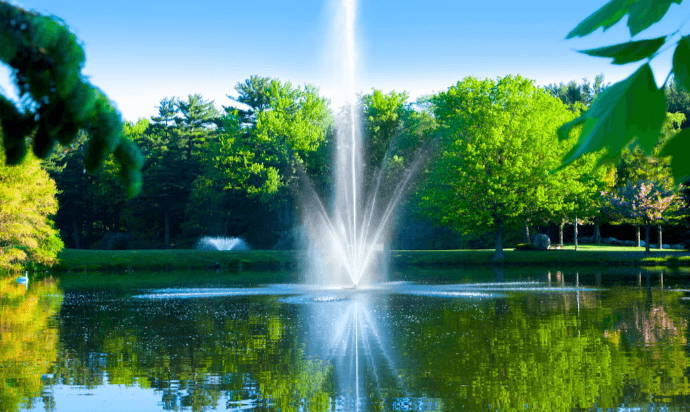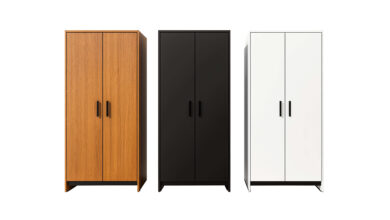Choosing the Right Aerating Pond Fountain: Factors to Consider for Effective Aeration

Nothing adds to a property’s natural beauty and tranquility quite like a pond. Preventing algae growth is a vital task in maintaining your water feature’s attractiveness and protecting any aquatic animals and wildlife living in the vicinity.
Keeping algae under control is a constant battle for pond owners as fully treating an algae bloom can cost up to $150 and take more than two months.
The best way to keep algae from growing is through a floating aerating pond fountains.
Why Use A Pond Water Fountain?
Ponds can quickly become oxygen-deficient if not properly aerated. Fish food and waste release nitrogen into the water. Decomposing plant matter such as tree branches and leaves uses up oxygen during decomposition and forms muck on the pond bed. Muck produces methane and sulfure, which is released when the muck is disturbed. These gasses have highly unpleasant odors that are nearly impossible to ignore.
Algae does extremely well in this nutrient-rich water while water lacking in oxygen and high in nitrogen and phosphate is deadly for fish and aquatic plants.
A pond water fountain solves this by spraying water through the air. The water droplets fall into the water, bringing air to the water. The fountain’s pump draws water into the fountain, circlating water from the edges of the pond to the center, allowing oxygenated water to reach the far corners of the pond.
The oxygen in the water feeds friendly bacteria that feeds on the same food as algae, effectively starving it and preventing bloom. Circulating water also prevents a buildup of fish waste and dead plant matter which can unbalance the pond’s delicate ecosystem.
In short, aerating your water keeps it healthy and more pleasant to be around. Nothing can ruin a pleasant afternoon next to the water feature like a dead fish or the unpleasant odor of stagnant water.
Aerating Pond Fountains vs. Pond Aerators
Pond owners have a plethora of options to choose from when circulating the water in your pond: pond fountains, pond aerators, windmills, diffusion aerators, or waterfalls. Which option is best for you will be contingent on the unique aspects of your pond.
Floating Fountain Pond Aerators
A pump forces water through a nozzle and up into the air. These nozzles have decorative patterns over the tip, creating the attractive shapes you see. A floating fountain creates a more attractive display but won’t circulate as much oxygen through the water as an aerator.
A common site on golf courses and landscape architecture, fountains are a great combination of beauty and mechanized efficiency. For smaller ponds, you won’t find a more efficient method of circulation. The downside is that they don’t work on deeper water and can incur ongoing upkeep costs.
Decorative Pond Aerators
A heavy-duty motor turns a boat propeller, forcing a large volume of water up in the air. Aerators are stronger and more efficient than fountains. A typical aerator can circulate almost twice as much water (measured in gallons per hour) as a floating fountain.
These aerators don’t run any water through the motors and don’t have nozzles like fountains so you don’t have to deal with any clogs or blockages. On the downside, aerators lack the aesthetically-pleasing shapes or displays of fountains.
Decorative aerators are more expensive than fountains, though, and require costlier regular maintenance.
Submerged Diffused Aerators:
This system sits on the bed of the pond and forces air through a system of tubes. The air forms bubbles and rise up to the top of the water. The newly oxygenated water sinks to the bottom of pond, bringing aerated water throughout the pond’s ecosystem.
Submerged aerators don’t create any effect beyond some surface bubbles but they are incredibly effective at doing their job.
Diffused aerators are the best option for deep ponds. However, many people dislike the lack of eye-catching displays. Plus, they’re not cheap. If you have a pond deeper eight feet deep, these are the aerators for you but you need to choose carefully before shelling out for their high price tags.
Windmill Oxygenation Systems
If you want that ‘wow’ factor with your pond, a windmill will certainly provide what you’re hoping for. Windmills use wind power to pump air through a compressor and into diffusers on the pond’s bed.
This aeration system has the advantage of not requiring electricity and can be customized to match the overall design aesthetic of the property. The downside is that windmills are large, bulky, and not a viable option for areas sheltered from the wind. The air diffusers also lose efficacy in larger bodies of water.
Natural or Artificial Waterfalls
Popular with pond owners looking for a natural ambiance, waterfalls are an aeration system that can only be described as “elegant”. Adding a waterfall to landscaping can be an effective way to add curb appeal to a property when it comes time to sell.
Since waterfalls look more natural than fountains or windmills, they can circulate water while blending into the background. The cons of a waterfall are that they take a long time to install and are expensive. They require regular upkeep and can spring a leak that will drain your pond if you don’t keep up with the maintenance.
Unfortunately, as nice as they look, waterfalls aren’t as good at aerating as fountains and diffused aerators.
Choosing Your Floating Pond Fountain
Every pond is unique in its own way. There are several things to consider when deciding on the aeration method for your pond. Exactly which solution is right for you will hinge on all of the following aspects.
Size of the Pond
Size is an immediate consideration when buying a pond fountain. Water features with large circumferences will require more power or several units to fully circulate the water.
Ponds are measured in acre feet, which isn’t a reference most people use very frequently. Luckily, there’s a good formula you can use to get a rough idea of your pond’s size and volume:
- Square ponds: Length x width x depth x 7.5 = total number of gallons
- Round ponds: length x width x depth x 5.9 = total gallons
There are 325,851.6 gallons per acre foot, so divide the total gallons by that number and you get the scope of your pond in acre feet.
Knowing this number will help you decide how strong you’ll need your aerator to be.
The Pond’s Shape
Shape also plays a significant role in deciding which fountain is right for you. Regularly shaped round ponds will likely require less power. Ponds with irregular shapes could create dead zones where aerated water can’t circulate. If you have a pond like this, you’ll need multiple fountains placed strategically to reach all corners.
Read also Guide to Choosing the Right Online Pharmacy
How Deep Is the Pond
Depth is a deciding factor in what aerator your pond needs. Floating pond fountains are perfect for ponds with 8 feet or less of water. Deeper than that and the oxygenated water won’t be able to reach the bottom layer, creating dead zones in the pond.
Ponds with deeper water will need a submerged diffusion aerator.
If you really want the visual touch of a dramatic fountain but have a deep pond, you can don’t have to choose between the two. Install a submurged aerator to fully aerate your pond while a floating fountain adds the finishing visual touch while further circulating air through the water.
The Fountain’s Power Source
Electricity-powered fountains are the most effective and efficient and are good for ponds close to the house. Solar and wind-powered fountains can provide power where no electricity is available. The downside with wind-powered fountains is that the unit can’t run without wind.
Wind and solar-powered aerators are more expensive but cost practically nothing to run. Electric fountains are cheaper but will add to your monthly utility bill.
Cost of Ownership and Maintenance Requirements
Like everything else in your home, your pond aerating system needs to be regularly maintained and may incur repair fees over the course of its lifetime. Some aerators have higher requirements than others.
Pond fountains need to be removed each winter before the water freezes and damages the pump. If you have any fish or aquatic plants, your ecosystem will be without aeration until Spring. The same with aerators. Icy conditions can damage the motor and propellor.
Sub-surface systems, on the other hand, are designed to withstand freezing conditions. So they can continue operating throughout the winter months.
In the end, the goal of aeration is to create a stable ecosystem for your pond. Pond aerators are a vital tool in preventing algae and keeping your pond healthy and floating fountains provide an attractive look and relaxing sound while doing it. If you balk at the idea of spending money on a circulation system for your pond, remember it will save you money in the long run while adding value to your property if you ever decide to sell.






